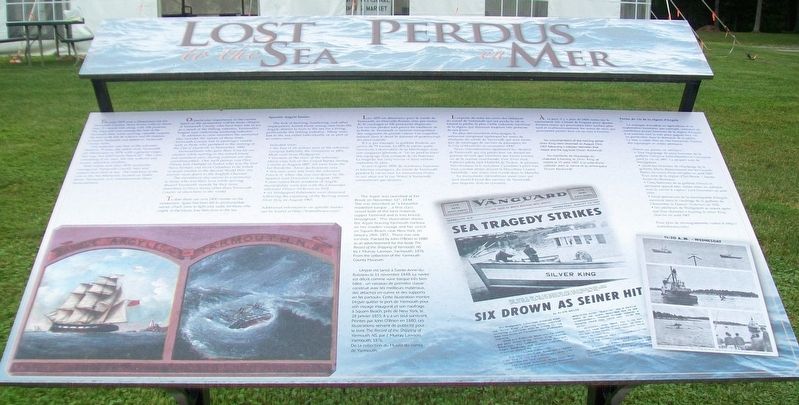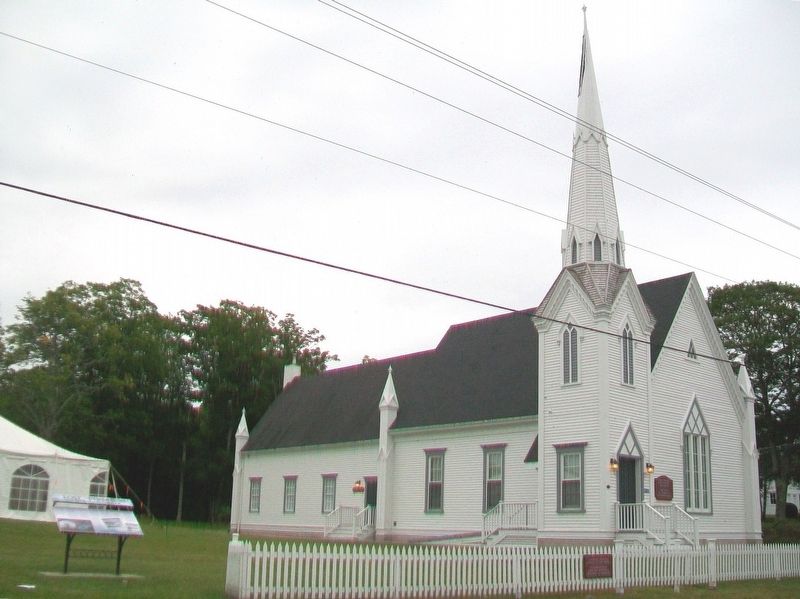Tusket in Yarmouth County, Nova Scotia — The Atlantic Provinces (North America)
Lost at Sea / Perdus en Mer
The year 1879 was a disastrous one for Yarmouth County, Nova Scotia, with no fewer than 31 vessels lost along with 106 persons. The ships lost were among the best of the Yarmouth fleet, some carrying valuable cargoes. The loss of life left 26 widows and 99 children to mourn husbands and fathers in Yarmouth County alone.
One instance was that of the schooner Boadicea, 79 tons; she sailed from Yarmouth for Martinique in 1879, with a general cargo, but was "not afterwards heard of." Her crew, consisting of six men, left five widows and sixteen fatherless children.
Both before and after 1879, numerous courageous Yarmouth County men and women have died at sea. The intention of the Lost to the Sea Memorial, located on Water Street, Yarmouth, is to commemorate these Yarmouthians.
Of particular importance in the names listed on the monument will be those citizens of Yarmouth County who have been lost at sea as a result of the fishing industry, Yarmouth's longest and continuing seafaring industry.
In addition to crew members the memorial also includes the names of those from Yarmouth County lost in passenger vessels such as those who perished in the sinking of the City of Monticello in November, 1900.
Yarmouthians who gave their lives for our country while serving in the armed forces and merchant navy during wartime are also commemorated. One such person was Pilot Officer Jack Hatfield of Tusket who was the first Nova Scotian and third Canadian to be killed in aerial combat in the Second World War- his aircraft went down in the English Channel.
The monument also serves as a memorial to those who lost their lives while serving aboard Yarmouth vessels, be they from elsewhere in Nova Scotia other than Yarmouth County or elsewhere in the world.
To date there are over 2400 names on the monument. Space has been left to accommodate names which come to light and, sadly, for those who might, in the future, lose their lives to the sea.
Specific Argyle losses:
The lack of farming, lumbering, and other employment, forced many young men from the Argyle district to turn to the sea for a living, particularly the fishing industry. Many were lost to the sea either individually or as part of an entire crew.
Included were:
• the loss of all sixteen men of the schooner Georginie (officially the Georgiana) in 1891. Most were from Wedgeport.
• fourteen of the crew of the schooner Maria were lost on the Grand Banks during a storm in August 1887. All were from the Eel Brook-Ste. Anne-du-Ruisseau area.
• five men were lost from the schooner Francis A. when she was run down by the steamer Lord Downshire in August, 1919.
• nine native-born residents of Argyle municipality were lost with the Gloucester schooner Eleanor Nickerson in 1932.
• six Wedgeport fishermen were drowned following the capsizing of the herring seiner Silver King in August 1967.
Additional information on specific names can be found at http://losttothesea.com/.
[Bottom left illustration caption reads]
The Argyle was launched at Eel Brook on November 11th, 1848. She was described as “a beautiful modelled barque …a first class vessel built of the best material, copper fastened and is iron kneed throughout.” This illustration shows the Argyle leaving Yarmouth harbour on her maiden voyage and her wreck on Squam Beach, near New York, on January 28th, 1855. There was one survivor. Painted by John O’Brien in 1880 as an advertisement for the book The Record of the Shipping of Yarmouth, NS by J. Murray Lawson, Yarmouth, 1876. From the collection of the Yarmouth County Museum.
Six crewmembers of the herring seiner Silver King were drowned on August 23rd, 1967 following a collision between that vessel and the tug boat Ocean Rockswift.
[French]
Il y a, par exemple, la goélette Brodicea [sic - Boadicea], un navire de 79 tonnes. En 1879, le navire quitte Yarmouth à destination de la Martinique avec une cargaison générale et "on en perd la trace". Son équipage était composé de six hommes. La tragédie fait cinq veuves et seize enfants orphelins de père.
Avant et après 1879, de nombreux hommes et femmes courageux du comté de Yarmouth perdent la vie en mer. Le monument Perdus en mer situé sur la rue Water, à Yarmouth, commémore ces citoyens.
Il importe de noter les noms des résidants du comté de Yarmouth qui ont perdu la vie en faisant la pêche, la plus vieille industrie maritime de la région qui demeure toujours très présente de nos jours.
En plus des membres d'équipages, le mémorial comprend également les noms de résidants du comté de Yarmouth qui sont morts lors de naufrages de navires de passagers, tel le City of Monticello en novembre 1900.
Nous commémorons également les citoyens de Yarmouth qui ont perdu leur vie durant les guerres en tant que membres des forces armées ou de la marine marchande. L’un d’eux était l’officer-pilote Jack Hatfield de Tusket, le premier Néo-écossais et le troisième Canadien à périr lors d’un combat aérien durant la Deuxième Guerre mondiale – son avion s’est écrasé dans la Manche.
Le monument commémore aussi ceux qui sont morts à bord des navires de Yarmouth, peu importe d’où ils venaient.
À ce jour, il y a plus de 2400 noms sur le monument. On a laissé de l'espace pour ajouter d'autres noms qui pourraient faire surface plus tard et malheureusement, les noms de ceux qui pourraient perdre leur vie en mer à l'avenir.
Pertes de vie de la région d’Argyle
Le manque d’emplois en agriculture et en exploitation forestière, par exemple, constraint de nombreux jeunes hommes de la région d’Argyle à se tourner vers la mer pour gagner leur vie, en particulier dans le domaine de la pêche. La mer a coûté cher en vies humaines. Parfois, des équipages en entier périssent.
Parmi ces pertes, on retrouve :
• Tout l’équipage de seize hommes de la goélette Georginie (officiellement le Georgiana) perd la vie en 1891. La plupart sont de Wedgeport.
• Quatorze hommes de l’équipage de la goélette Maria disparaissent sur les Grands Bancs au cours d’une tempête en août 1887. Tous sont de la région d’Eel Brook / Sainte-Anne-du-Ruisseau.
• Cinq hommes de la goélette Francis A. périssent quand leur voilier entre en collision avec le navire à vapeur Lord Downshire en août 1919.
• Neuf personnes de la municipalité d’Argyle meurent dans le naufrage de la goélette de Gloucester, le Eleanor Nickerson en 1932.
• Six pêcheurs de Wedgeport se noient après que leur chalutier à hareng, le Silver King, chavier en août 1967.
Pour plus de renseignements visitez le http://losttothesea.com/.
[Légende des illustrations]
L’Argyle est lancé à Sainte-Anne-du-Ruisseau le 11 novembre 1848. Le navire est décrit comme «une barque très bien bâtie… un vaisseau de première classe construit avec les meilleurs matériaux, des attaches en cuivre et des supports en fer partout». Cette illustration montre l’Argyle quitter le port de Yarmouth pour son voyage inaugural et son naufrage à Squam Beach, près de New York, le 28 janvier 1855. Il y a un seul survivant. Peintes par John O’Brien en 1880, ces illustrations servent de publicité pour le livre The Record of the Shipping of Yarmouth, NS. par J. Murray Lawson, Yarmouth, 1876. De la collection du Musée du comté de Yarmouth.
Six membres de l’équipage du chalutier à hareng, le Silver King, se noient le 23 août 1967 à la suite d’une collision avec le navire et le remorqueur Ocean Rockswift
Topics and series. This historical marker is listed in these topic lists: Disasters • Waterways & Vessels. In addition, it is included in the Lost at Sea series list. A significant historical date for this entry is January 28, 1855.
Location. 43° 51.275′ N, 65° 58.474′ W. Marker is in Tusket, Nova Scotia, in Yarmouth County. Marker is on the Lighthouse Route (Nova Scotia Route 3), on the right when traveling north. Touch for map. Marker is at or near this postal address: 8168 Nova Scotia Route 3, Tusket NS B0W 3M0, Canada. Touch for directions.
Other nearby markers. At least 8 other markers are within 5 kilometers of this marker, measured as the crow flies. Argyle Township Court House and Gaol (a few steps from this marker); Law in Nova Scotia / La Loi en Nouvelle-Écosse (within shouting distance of this marker); The/Le Village of Tusket (within shouting distance of this marker); Palais de justice et Prison d’Argyle / Argyle Township Court House and Gaol (within shouting distance of this marker); United Empire Loyalists (about 150 meters away, measured in a direct line); World Wars Memorial (about 150 meters away); Barges de foin salé de Buttes-Amirault (approx. 3.6 kilometers away); Saint Anne Catholic Church Veterans Memorial (approx. 3.7 kilometers away). Touch for a list and map of all markers in Tusket.
Related markers. Click here for a list of markers that are related to this marker.
Credits. This page was last revised on January 27, 2024. It was originally submitted on January 1, 2018, by William Fischer, Jr. of Scranton, Pennsylvania. This page has been viewed 256 times since then and 17 times this year. Photos: 1, 2. submitted on January 1, 2018, by William Fischer, Jr. of Scranton, Pennsylvania.

